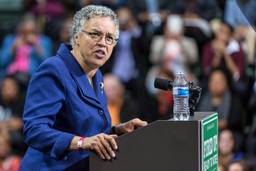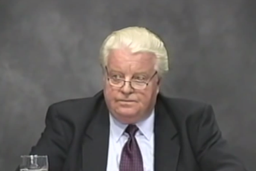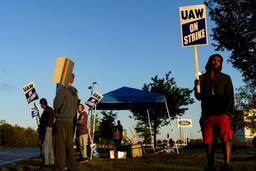
Renowned Chicago labor attorney Thomas Geoghegan paused for the third time and, with a slight sigh, asked federal district judge John Lee, “Your Honor, could you instruct the witness to answer the question ‘Yes’ or ‘No’?”
After days of often highly technical testimony, patience seemed to be wearing thin on Thursday, July 18, the third and next-to-last day of hearings on an injunction brought by Chicago Public Schools (CPS) parents of students with special needs to prevent CPS from closing 50 schools.
The parents, who are suing to halt the school closings on the grounds that they violate the Illinois Civil Rights Act and the Americans with Disabilities Act, have filed for a preliminary injunction, saying that students will suffer irreparable harm if the schools are closed before the full case goes to trial.
The recalcitrant witness Geoghegan faced was Markay Winston, chief officer of the Chicago Public Schools’ Office of Special Education and Supports (OSES). She had been called as Chicago Public Schools’ expert on the impact of school closures on students with disabilities. In cross-examination, Geoghegan grilled Winston on whether CPS had done its homework before deciding to close the schools.
“Can you point us to any peer-reviewed literature regarding the effect of school closures on special education students?” he asked. Winston was unable to do so, saying that the matter has not been studied directly.
“Have you read the RAND study?” No, she had not.
“Have you read the Consortium study?” No; she had looked at “parts” of it. This revelation elicited some guffaws from the gallery; the study by the Chicago Consortium on School Research at the University of Chicago has been widely read in the Chicago education community.
“Are you aware of the Catalyst story?” (The article, from the Spring 2013 issue of Catalyst Chicago, found that after one series of school closures, the district “lost track” of 11 percent of the students affected.)
Winston said she was not aware of the story, nor did she know whether anyone on her staff had seen it.
The thrust of Geoghegan’s cross-examination, and the tenor of the hearings generally, was to establish the carelessness with which CPS undertook the largest round of public school closings in American history.
In May, the Chicago Board of Education, the mayorally appointed body responsible for the Chicago Public Schools, voted along the recommendations of CPS CEO Barbara Byrd-Bennett to close 50 schools and send the students to “welcoming schools.” CPS’s criteria for school closures focused almost exclusively on determining whether schools were “underutilized” — whether enrollment had fallen below what the number of rooms in the school building should be able to support. The announcement, which came despite anti-closure protests throughout the winter and spring, was met with outrage by many Chicago communities and by the Chicago Teachers Union.
The studies Geoghegan cited suggest that a sudden change in school environment is traumatic for students, although it’s unclear whether the effects are lasting. The RAND/Vanderbilt study found that unless the welcoming schools are “substantially higher-performing” than the closing schools, there is no benefit for students and possibly some harm. Research by the Chicago education news and research magazine Catalyst suggests the receiving schools are not significantly better, at least as measured by their test scores.
But parents of children with special education needs are particularly concerned. They argue that a traumatic, sudden relocation to a new school will permanently damage their children’s education, which is governed by legally mandated “individualized education programs,” or IEPs, developed with special education teachers, the students, parents and administrators. By moving to new schools, the IEP process may have to be rebooted or retooled. In fact, Winston suggested in her testimony that the district would alter the instructional minutes dictated by a child’s IEP based on the resources of the receiving school, which caused audible gasps in the gallery from the plaintiff parents.
In their suit, the parents are arguing that the city did not take the particularized needs of children with special education needs into account when ordering the closings. Under the Americans with Disabilities Act, a government discriminates when it uses decision-making criteria that are discriminatory in their effect, without sufficient justification. If Winston and CPS didn’t look for less discriminatory alternatives when making the closure decisions, it will be hard for them to defend those decisions in the subsequent trial, which may be grounds enough for a preliminary injunction. The plaintiffs have hammered on the fact that CPS’s closure criteria considered almost exclusively the “utilization” — the ration of enrollment to building size — of schools. In response, Winston stressed that the district will use “transition supports” for special ed students changing schools, such as tutoring, mentoring and one-on-one counseling.
The parents also argued that when determining whether a school was “underutilized,” CPS ignored the need for dedicated classrooms for small-sized special-education “clusters.” To rebut this argument, CPS called its second witness of the day, Adam Anderson, the chief officer of “Portfolio and Planning” for CPS and one of the developers of the closure criteria. Anderson testified that special-ed classrooms were accounted for in the utilization formula by an allowance for up to 20 percent of classroom space. Despite this discount, however, research by Jeanne Olson, a CPS parent and researcher at Northwestern University’s School of Education and Social Policy, suggests the formula currently in use is still insufficient to account for special-ed use of classrooms.
On cross examination, Anderson testified that Byrd-Bennett never asked his office to consider the impact of school closures on special education students, specifically.
If the court issues the injunction, CPS would be required to prevent implementation of the school closure plan for at least a year. The parties’ briefs on the injunction are due in early August, with a decision expected later that month.

I hope you found this article important. Before you leave, I want to ask you to consider supporting our work with a donation. In These Times needs readers like you to help sustain our mission. We don’t depend on—or want—corporate advertising or deep-pocketed billionaires to fund our journalism. We’re supported by you, the reader, so we can focus on covering the issues that matter most to the progressive movement without fear or compromise.
Our work isn’t hidden behind a paywall because of people like you who support our journalism. We want to keep it that way. If you value the work we do and the movements we cover, please consider donating to In These Times.





